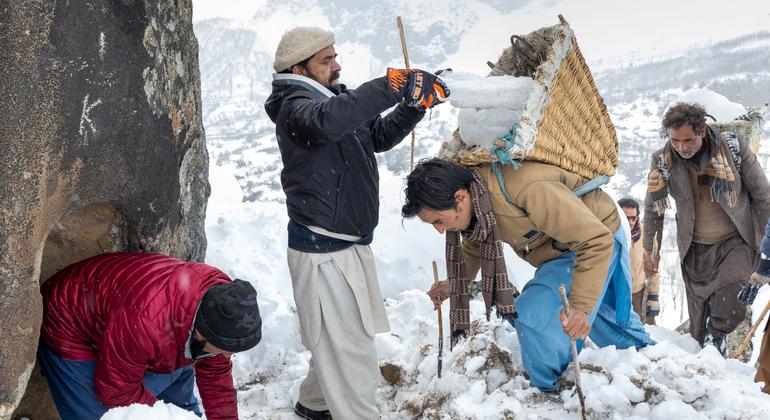The Indus and its tributaries have nourished human civilization in the Indian subcontinent since the Bronze Age.
Hundreds of years later, in modern Pakistan, water, food, employment – and to a large extent the country’s identity – still depend on this river. The Indus River flows for a length of 3,000 km from the Tibetan Plateau to the Arabian Sea.
But the Indus and its water source, the vast Himalayan glaciers, are increasingly facing an unprecedented threat: the river region has been hit countless times in recent years by severe floods caused by climate change.
There is concern about environmental damage due to these disasters, in view of which the ‘Living Industries’ initiative is being fast-tracked. The initiative is an ambitious effort to restore degraded river ecosystems and protect the lives and livelihoods of millions of people.
It uses traditional methods, from growing mangroves in the Indus delta to creating small glaciers high in the mountains to increase water supplies.
This initiative led by the Government of Pakistan was awarded the World Restoration Flagship Award this year. The award is part of the United Nations Decade on Ecosystem Restoration and honors initiatives that help protect and restore the natural world.
More than 10 lakh hectares of land has been successfully reclaimed under this initiative. The project plans to restore 25 million hectares by 2030.

Inger Andersen, Executive Director of the United Nations Environment Program (UNEP), said, “The devastation caused by climate change in Pakistan in recent years is heartbreaking. They have wreaked havoc on a scale that no country can accept, and neither should you.” ”
He said it is important to recognize and support projects like the ‘Living Indus’ initiative as they can instill hope and resilience in Pakistan and the entire region.
A nationwide movement
Launched in 2021, the initiative aims to expand conservation measures for the natural resources of the Indus Valley. It is home to 90 percent of Pakistan’s population, and is also the main source of irrigation for 80 percent of its arable land.
Its main objective is to make Pakistan more resilient to climate change. Besides ensuring water supply for homes, farms and factories, the initiative aims to reclaim 40 percent of the Indus Valley area within Pakistan by 2030 and create more than 2 lakh green jobs.
Around 1.3 lakh hectares of land has been reclaimed so far through afforestation and establishment of protected areas. These measures are expected to help conserve endangered wildlife, from snow leopards to river dolphins.

Disaster Management
In 2022, about 33 million people in Pakistan were affected by floods after torrential rains. More than 1,700 people were killed and US$30 billion in damage. Hundreds of people have died in floods this year as well.
Many of the victims were residents of densely populated low-lying areas of Sindh province. That is why under this initiative, the focus is on restoring natural infrastructure like wetlands and promoting climate-efficient agricultural practices.
This can reduce floods, storms, extreme heat and other climate-related risks, but the dangers persist at mountain heights.
Komal Sher, a schoolgirl from Hasnabad in the Gilgit-Baltistan region, still remembers that painful day in 2022, when a large part of her town, including the highway bridge, was swept away by floods caused by the meltwater of a tributary Shiok. Indus.
Looking at the pile of bricks where his house once stood, he says, “The flood washed away not only my house but also all my childhood memories.”
The flood was caused by extremely high temperatures, which caused the Schispa glacier to form a lake behind it. The waters of this overflowing lake eventually burst its banks and overflowed, sending a terrifying wave of water and debris into the valley below.
Experts worry that climate change is increasing the likelihood of floods from such glacial lakes in the Himalayas and other mountainous regions. In October 2023, floods in the Indian state of Sikkim killed more than 90 people, destroyed a hydroelectric dam, and submerged villages as far away as Bangladesh.

Living Indus initiative coordinator Jehanzeb said the initiative focuses on community-based disaster risk management, flood protection and early warning systems, “with the aim of really building community resilience to any kind of disaster,” he said.
Respect the river
The project under the Living Indus initiative has been implemented in 25 sectors and is estimated to cost USD 11-17 billion. With recognition as the World Restoration Flagship Award, the initiative will now be eligible for additional technical and financial support from the United Nations.
Jehanzeb said that Pakistan may be able to give something back to the Indus Valley by taking advantage of this support and taking the program forward.
He said, “(Sindus) is the backbone of Pakistan. Everything we are is because of Sindus. So, the real question is: Can we support Sindh for the next 100 years?”


